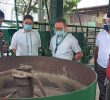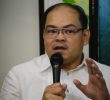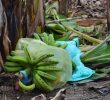DAVAO CITY — Agricultural developments in Davao City�s third district were blamed for the alarming condition of the rivers as awareness for the protection of the environment against destructive development continues to grow.
Councilor Felix Torres of the village of Gumalang said the presence of the plantations in his village have caused the Gumalang River, a tributary to Davao River, to become polluted.
Torres, a member of community-based water monitors called Bantayo Aweg (a monobo term for water guardians), said plantations in the village have encroached even the areas allotted as bufferzones, something that caused frequent soil erosion.
This is aside from the runoffs of wastes from the plantations and other agricultural activities that go directly to the Gumalang River.
�We are asking the help of concerned agencies who are responsible for enforcing policies on bufferzone because they have never been followed in by the plantations�if you will go into our villages, you will see that the absence of bufferzones have caused soil erosion aside from the wastes of plantations that finds its way into the river,� Torres said.
For almost two years, Bantayo Aweg volunteers have monitored Gumalang Rivers and the Tamugan-Panigan Rivers, which were also monitored by Bantayo Aweg monitors from the villages of Carmen and Tawan-Tawan.
Compared to the two other rivers, the Gumalang River has the worst water quality.
The result of Bantayo Aweg monitoring says that the water quality of Gumang River was the worst in terms of color, which indicated soil erosion. The river also showed high value of total dissolved solids (TDS) compared to the other rivers.
The Environment Management Bureau of the Department of Environment and Natural Resources also made their own analysis on total dissolved solids (TSS) and the same trend showed (34mg/liter).
Although admitting that the result was not yet too alarming as it still within the acceptable level set by Department Administrative Order 34 at 50mg/liter, an EMB official said it would be best for the residents and officials of Gumalang to be picky about which agricultural development shall be allowed in the village.
�If you can�t improve, I hope that you can maintain the quality of the river. I also hope that you can lobby in your Barangay to only choose what are the agricultural activities which will be allowed�you have to be very vigilant,� said Engr. Myhrra Fair Barquilla, environment management specialist of EMB-DENR.
Martin Obrero, supervising environmental management specialist of the City environment and natural recources, also said that they were �worried of the quality of water in the Gumalang River.�
�We recommend for the continued monitoring of the river in Gumalang. And we hope that we will not let our guards off and not allow environmentally destructive activities in the village,� Obrero said.
The Gumalang River also showed higher values in terms of nitrate and phosphates compared to the stations monitored in Tawan-Tawan and Carmen. In terms of land use in the surrounding areas, the Gumalang area is also the most intensively farmed compared to Carmen and Tawan-Tawan.
In their report, the Bantayo Aweg recommended for the mapping of the land uses in the areas surrounding the stations to point out the potential sources of contaminants.
They also want to government to strictly enforce the 20-meter bufferzones between rivers and plantations to and plant bufferzones with diverse trees and bamboos. The group also wants others, especially the youth, to join them in monitoring the rivers.










